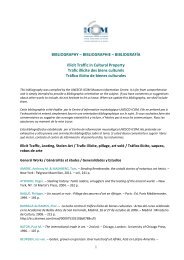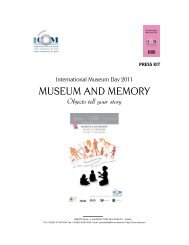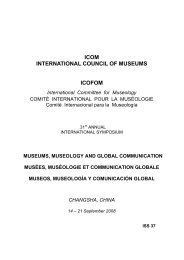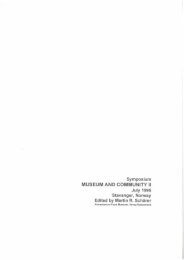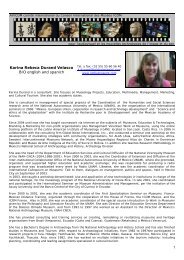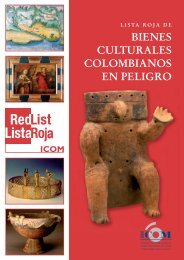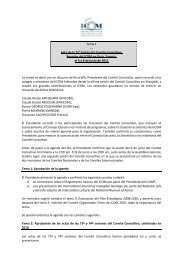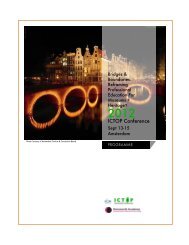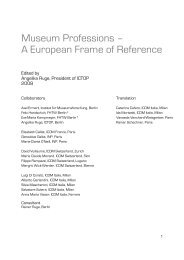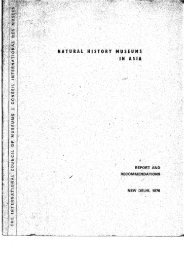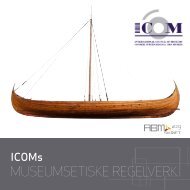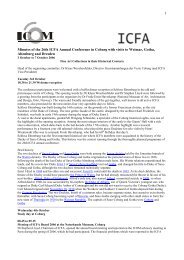Key Concepts of Museology - ICOM
Key Concepts of Museology - ICOM
Key Concepts of Museology - ICOM
You also want an ePaper? Increase the reach of your titles
YUMPU automatically turns print PDFs into web optimized ePapers that Google loves.
24<br />
New functions that emerged in<br />
the second half <strong>of</strong> the 20 th century<br />
led to major architectural changes:<br />
the increase in the number <strong>of</strong> temporary<br />
exhibitions led to a different<br />
distribution <strong>of</strong> collections between<br />
the permanent exhibition and storage<br />
spaces; the development <strong>of</strong> visitor<br />
facilities, educational workshops<br />
and rest areas, in particular the creation<br />
<strong>of</strong> large multi-purpose spaces;<br />
the development <strong>of</strong> bookshops, restaurants<br />
and shops for selling items<br />
relating to the exhibitions. But at the<br />
same time, the decentralisation by<br />
regrouping and by subcontracting<br />
some museum operations required<br />
the building or installation <strong>of</strong> specialised<br />
autonomous buildings: fi rstly,<br />
restoration workshops and laboratories<br />
which could specialise while serving<br />
several museums, then storage<br />
areas located away from the exhibition<br />
spaces.<br />
The architect is the person who<br />
designs and draws the plans for<br />
the building and who directs its<br />
construction. More broadly speaking,<br />
the person who designs the<br />
envelope around the collections,<br />
the staff and the public. Seen from<br />
this perspective, architecture affects<br />
all the elements connected with the<br />
space and light within the museum,<br />
aspects which might seem to be <strong>of</strong><br />
secondary importance but which<br />
prove to be determining factors for<br />
the meaning <strong>of</strong> the display (arrangement<br />
in chronological order, visibility<br />
from all angles, neutral background,<br />
etc.). Museum buildings are thus<br />
designed and built according to an<br />
architectural programme drawn up<br />
by the scientifi c and administrative<br />
heads <strong>of</strong> the establishment. However,<br />
the decisions about defi nition <strong>of</strong><br />
the programme and the limits <strong>of</strong> the<br />
architect’s intervention are not always<br />
distributed in this way. Architecture,<br />
as art or the method for building and<br />
installing a museum, can be seen as<br />
a complete oeuvre, one that integrates<br />
the entire museum mechanism.<br />
This approach, sometimes advocated<br />
by architects, can only be envisaged<br />
when the architectural programme<br />
encompasses all the museographical<br />
issues, which is <strong>of</strong>ten far from being<br />
the case.<br />
It can happen that the programmes<br />
given to the architects include<br />
the interior design, allowing the<br />
latter – if no distinction is made<br />
between the areas for general use<br />
and those for museographical use<br />
– to give free rein to their ‘creativity’,<br />
sometimes to the detriment <strong>of</strong><br />
the museum. Some architects have<br />
specialised in staging exhibitions<br />
and have become stage designers or<br />
exhibition designers. Those who can<br />
call themselves ‘museographers’, or<br />
specialists in museum practice are<br />
rare, unless their practices include<br />
this specifi c type <strong>of</strong> competence.<br />
The present diffi culties <strong>of</strong> museum<br />
architecture lie in the confl ict which<br />
logically exists between, on the one<br />
hand, the ambitions <strong>of</strong> the architect<br />
(who will fi nd himself in the spotlight<br />
due to the international visibility<br />
<strong>of</strong> this type <strong>of</strong> building today), and on



